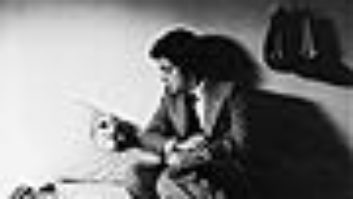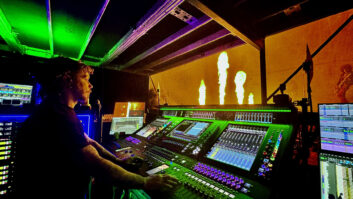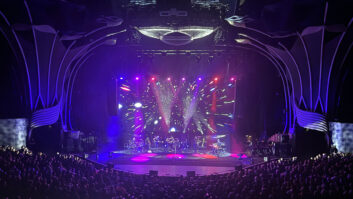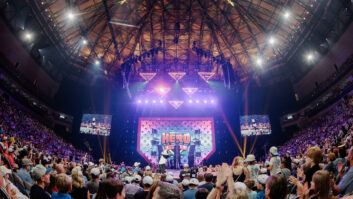
Wantagh, NY—Envision the seamless marriage of a 50-piece symphony with a supremely powerful rock band. Not every group could pull that off, but Rock and Roll Hall of Fame godfathers The Who might just be the dream partner for any orchestra. The Who’s Moving On! North American symphonic tour proved that nightly as it took the band on a 31-date trek through the fall of 2019, with the band teaming up each night with regional classical musicians assembled specially for the evening.
The Who’s legendary guitarist Pete Townshend and vocalist Roger Daltrey have a proven track record of blending a half-century of rock classics with classical sensibilities, and the resulting tours have proven tremendously popular with their fan base. “Pete liked the idea of doing another symphonic tour,” said FOH orchestra engineer Chris “Chopper” Morrison, “especially after Roger did his solo Tommy tour last year from top to bottom with an orchestra.” Chopper has served as systems engineer since the band’s 50th anniversary tour of 2014-16 on behalf of the group’s audio provider, Eighth Day Sound.
“Roger wanted the orchestra to feel powerful—but that doesn’t mean loud,” said Robert Collins, the band’s longtime FOH engineer, who is devoted to the core band mix. “That was the challenge: striking that balance of intimate feel with power.” Chopper and Collins set up camp daily around a DiGiCo SD7 desk with a 24-fader EX-007 sidecar unit for the orchestra, which was the same arrangement used on Daltrey’s Tommy tour. “It’s the top tier of what’s available now,” said Collins, an SD7 stalwart who uses an identical console on tours with Eric Clapton. “The SD7 is excellent to work with because you see everything with just the flick of a button, so we do four things at once with just two hands,” Collins said. “This show is nonstop hands-on, and you can do it with these DiGiCo boards.”

The blending of two sonically separate worlds obviously creates some challenges. “It’s quite hard,” said Chopper. “There’s in excess of 150 open mics up there all the time—and then you’ve got The Who!” Collins admitted Townshend had concerns when the tour started. “Pete was looking at placements and thinking he was going to overpower the instruments around him, but we’ve gotten around that somehow. Pete and the band are getting the drive they want, while the crispness and range of the orchestra can still be heard.”
Helping ensure that happened, The Who’s nightly Moving On! orchestra was close-miked with no overheads, and microphone selection was key. Shure KSM32s captured the brass section, while AKG C414s were used on percussion instruments and Neumann KM 184s grabbed tympani. “We’ve been changing things as we’ve gone along with different orchestras,” said Collins. “One big thing this time out is that we’re using the new DPA d:vote Core 4099s clipped onto all the violins, violas, cellos and woodwinds. They’re great quality mics. If you’re going to get a lot of spill on stage, you want quality spill.” While most of the strings were captured on wired mics, the string soloists had a measure of mobility as they used Shure Axient wireless systems.
“The DPA mics are rock solid,” agreed monitor tech John Switzer. “We’ve used them for months now and haven’t had any failures. We’ve got Barcus Berry pickups on the basses and these great Schertler pickups on the cellos; they’re very easy to install and remove.”
The Who: From Purple Hearts to Power Chords, by Carol Clerk, Classic Rock

The band has held a Shure sponsorship in excess of 50 years. Members are outfitted entirely from the company’s vocal mic line. This includes Daltrey’s trademark Shure Beta 58A microphone, double-cabled and gaff-taped securely at the mic stem to guard against mishaps during his infamous mic swinging antics. “After 55 years, I’m sure he’s hit something at some point,” said Chopper, adding that if so, it hasn’t happened during his time with the band.
The Moving On! tour carried an Adamson Systems Engineering E-Series system. While the arrangements changed subtly from venue to venue, the system in whole was based around main hangs of 15 E15 three-way, true line source enclosures over three E12 three-way, full-range enclosures per side. At the sides were hangs of 12 E15s over three E12s per side, along with 270-degree fills from Adamson’s S-Series, with four narrow-dispersion S10n two-way, full-range cabinets over eight standard S10s per side. Covering the front rows, S10s and S7p point-source cabinets were employed as front fills. Supporting all that in the low end was a hybrid system of nine flown E119 subs per side and an additional dozen E119s, stacked in front of the stage.
The Lab.gruppen-powered Adamson rig may have the audience covered, but on stage, the monitor engineers faced the prospect of mixing for enough musicians to constitute an entirely second audience. Aside from Townshend, all the musicians on stage wore in-ear systems and followed a click track. “Due to Pete’s hearing loss, it’s one big challenge all the time for the monitor guys,” said Collins. “It’s a bit harder with Pete’s quite-loud monitors but, again, we’ve gotten around that with trial and error.”

As a result, stage monitoring was handled with d&b audiotechnik monitors across the stage, including a dozen M2 wedges, a trio of V-Sub subwoofers, a pair of Q10 speakers and 10 E8 speakers, all sharing mixes from two DiGiCo SD7 Quantum desks with SD Racks.
“Our biggest challenge is cable management,” said Switzer, who has worked on large tours with Madonna, Coldplay and Widespread Panic. “This tour has 167 inputs, so that’s about a half mile of cable. Each orchestra member has a headphone amp for clicks, and the band has 64 inputs, plus some tracks. The orchestra has 67 mics, and each of those inputs has 10 to 25 feet of XLR cable.” With all that to set up daily, Switzer was relieved to have the support of his team. “My boys help me out miking the stage each night, so I’m not up there by myself doing all this,” he said. “Otherwise it’s like banging in a 6-inch nail with a feather.”
To achieve better band-to-orchestra balance, Townshend, his brother, guitarist Simon Townshend, and bassist Jon Button scaled their guitar rigs down; additionally, drummer Zak Starkey played a completely electronic kit. “That’s helped the whole band to quiet down a bit,” said Chopper, “but when we started doing the orchestra shows, the hardcore fans who’ve been seeing The Who for years and years were moaning that it wasn’t loud enough up front. They’re used to the drums bashing them! We had to increase the ground system speakers up front and now they’re satisfied.”
At the FOH position, the outboard racks were full, with classics like Summit TLA100 and dbx 160SL compressor/limiters, and TC Electronic M6000 and M5000 reverbs. “There’s no Waves [SoundGrid] or plug-ins,” said Chopper. “Likewise, the only prerecorded tracks used are a few Who bits that everyone knows, like the intro to ‘Baba O’Riley.’ Everything else is live.”
What Happened When The Who Took On America, by Mark Blake, Classic Rock

Despite the infamous half-century legend of The Who as ‘the loudest rock band on the planet,’ the house mix never went over 102 dB on the orchestral Moving On! tour. “With The Who, bottom end is a thick issue,” said Chopper. “It’s not a hip-hop show. We use a stereo line signal conditioner, the ,, across the left and right because there’s so much ‘mud-range’ and that improves the sound a bit.”
Also, no snapshots were used in this “hands-on” show. “We’re mixing as it goes, and every night is different,” he added. “The orchestral parts have their music to follow, but the band never play the same thing twice. Basically, we hear it, we do it.”
The philosophy behind the mix was simple, with the orchestra treated as one big instrument alongside all the other band instruments. “We try and make it a rock show but not lose the orchestra feel,” said Chopper. “Sometimes it will be Pete wailing away on the guitar with the orchestra in the background. Other times, the orchestra will come out clear and lovely, and you’ll hear them predominantly over the rest of the band. But Roger’s vocal? That’s the main thing—he must be heard over all of it.”
In addition to presenting classic tracks in new arrangements, Moving On! also provided a vehicle for premiering new tracks from Who, the band’s 12th studio album, released in November 2019. “They’re trying to get settled with the way the new songs are arranged,” said Chopper, “so it makes it harder for us if they’re not gelling in. But the last few shows, the new songs are starting to have a great feel.” When the tour resumes, crossing the UK in March before returning to the States in April, the band will focus more deeply on material from the new record.
“This show is definitely an emotional journey because of all the orchestration,” said Switzer. “The band is 100 percent true on stage. They let their hair down when they speak to the audience. They don’t have ego. They’re one with their music and they’re one with their crew. They’re wonderful human beings.”
“There’s nothing like being here live seeing this band with an orchestra,” adds Chopper. “It’s like, would you rather be on a Skype call with your wife or girlfriend or in the same room with her? It’s about the feel.”
| VITAL STATS | |
| The Who | |
| Eighth Day Sound (Highland Heights, OH) | |
| FOH Engineer: | Robert Collins |
| FOH Orchestra Engineer: | Chris “Chopper” Morrison |
| Monitor Engineer: | Simon Higgs |
| Monitor Engineer: | Trevor Waite |
| Systems Engineer: | Ben Smith |
| Monitor/Stage/Pro Tools Tech: | John Switzer |
| P.A. Techs: | Tom Lawn, Shawn Tingle |
| FOH Console: | DiGiCo SD7 with EX-007 sidecar |
| Monitor Console: | (2) DiGiCo SD7 Quantum |
| House Speakers: | Adamson E15, E12, S10, S10N, S7, E119 |
| Monitor Speakers: | d&b audiotechnik M2, V-Sub. Q10, E8, |
| Personal Monitors: | Shure PSM 1000; Fischer Amps Hardwired IEM Headphone Amplifier |
| House Amplifiers: | Lab.gruppen |
| Monitor Amplifiers: | d&b audiotechnik D80 |
| FOH Equipment/Plug-Ins: | Summit Audio TLA100, DCL200; TC Electronic System 6000, M5000; Sonic Farm Creamliner; dbx 160SL; |
| Monitor Equipment/Plug-Ins: | Bricasti M7; Smart Research C2; Summit TLA100, DCL200 |
Eighth Day Sound • www.8thdaysound.com
Adamson Systems Engineering • www.adamsonsystems.com






